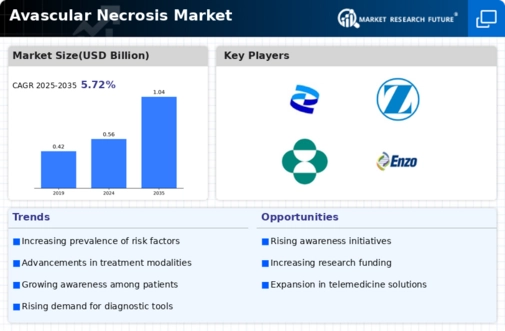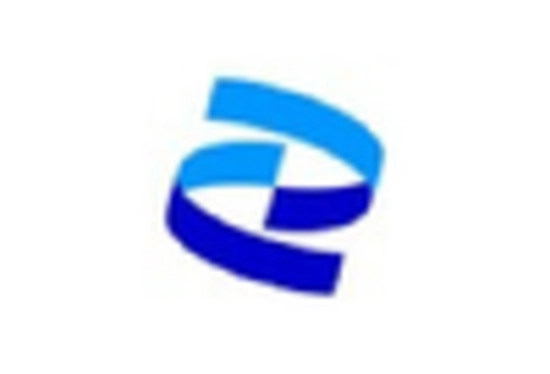-
Executive Summary
-
Market Introduction
-
Scope Of Study 32
-
Research Objective 32
-
List Of Assumptions 32
-
Market Structure 33
-
Research Methodology
-
Research Process 35
-
Primary Research 36
-
Secondary Research 37
-
Market Size Estimation 37
-
Forecast Model 38
-
Market Dynamics
-
Introduction 40
-
Drivers 41
- Increasing Awareness Along With The High Prevalence Of The Avascular Necrosis Disease 41
- Rising Preference Of Surgeries To Cure Osteonecrosis 41
- Rising Preference Of Bone Grafting Surgical Procedures With The Less Pain Substitute Procedures 41
- Consolidation Of Large Healthcare Providers In The U.S. 42
- Technological Advancements In The Development Of Surgical Implants 42
-
Restraints 42
- The High Cost Of Surgical Procedures And Related Side Effects 42
- Worsening Regulatory Landscape And Growing Cost Of Noncompliance In Developed Countries 43
-
Opportunities 43
- Growing Demand For Non-Invasive Treatments For Faster Recovery 43
-
Technology Trends & Assessment 44
- Acceptance Of Synthetic Bone-Graft Over Natural Ones 44
- Nanotechnology 44
- Rising Demand For Incorporating Recombinant DNA Technology In Surgical Implants 44
- Development Of Titanium-Foam Implant For Bone Grafting 44
- Customized Degradable Implants 44
-
Market Factor Analysis
-
Porter’s Five Forces Model 46
- Bargaining Power Of Suppliers 46
- Bargaining Power Of Buyers 47
- Threat Of New Entrants 47
- Threat Of Substitutes 47
- Intensity Of Rivalry 48
-
Value Chain Analysis 48
- Research & Development 48
- Manufacturing 49
- Distribution 49
- Marketing & Sales 49
- Post-Sales Monitoring 49
-
Epidemiology Of Avascular Necrosis 49
-
Avascular Necrosis Market, By Type
-
Introduction 54
-
Non-Trauma Related Avascular Necrosis 55
- Age Group 56
- Causes 58
-
Trauma-Related Avascular Necrosis 62
-
Avascular Necrosis Market, By Site
-
Introduction 64
-
Hip Bone 65
-
Knee 66
-
Shoulder 67
-
Avascular Necrosis Market, By Diagnosis
-
Introduction 69
-
Imaging 70
- X-Ray 72
- CT Scan 72
- MRI 73
- PET 74
-
Biopsy 74
-
Avascular Necrosis Market, By Treatment
-
Introduction 77
-
Medication 78
- Medication By NSAIDs (Non-Steroidal Anti-Inflammatory Drugs) 79
- Medication By Bisphosphonates 79
- Medication By Blood Thinners 80
-
Electrical Stimulation 81
-
Gene Therapy 82
-
Surgery 82
- Core Decompression 83
- Osteotomy 84
- Bone Graft 85
- Arthoplasty 85
-
Avascular Necrosis Market, By End-User
-
Introduction 88
-
Hospitals & Clinics 89
-
Diagnostic Centers 90
-
Ambulatory Surgical Centers 91
-
Global Avascular Necrosis Market, By Region
-
Introduction 93
-
Americas 103
-
Avascular Necrosis Market, By Type
-
Avascular Necrosis Market, By Site
-
Avascular Necrosis Market, By Diagnosis
-
Avascular Necrosis Market, By Treatment
-
Avascular Necrosis Market, By End-User
-
North America 112
-
Avascular Necrosis Market, By Type
-
Avascular Necrosis Market, By Site
-
Avascular Necrosis Market, By Diagnosis
-
Avascular Necrosis Market, By Treatment
-
Avascular Necrosis Market, By End-User
-
U.S. 123
-
Avascular Necrosis Market, By Type
-
Avascular Necrosis Market, By Site
-
Avascular Necrosis Market, By Diagnosis
-
Avascular Necrosis Market, By Treatment
-
Avascular Necrosis Market, By End-User
-
Canada. 131
-
Avascular Necrosis Market, By Type
-
Avascular Necrosis Market, By Site
-
Avascular Necrosis Market, By Diagnosis
-
Avascular Necrosis Market, By Treatment
-
Avascular Necrosis Market, By End-User
-
South America 140
-
Avascular Necrosis Market, By Type
-
Avascular Necrosis Market, By Site
-
Avascular Necrosis Market, By Diagnosis
-
Avascular Necrosis Market, By Treatment
-
Avascular Necrosis Market, By End-User
-
Europe 149
-
Avascular Necrosis Market, By Type
-
Avascular Necrosis Market, By Site
-
Avascular Necrosis Market, By Diagnosis
-
Avascular Necrosis Market, By Treatment
-
Avascular Necrosis Market, By End-User
-
Western Europe 160
-
Avascular Necrosis Market, By Type
-
Avascular Necrosis Market, By Site
-
Avascular Necrosis Market, By Diagnosis
-
Avascular Necrosis Market, By Treatment
-
Avascular Necrosis Market, By End-User
-
Germany 170
-
Avascular Necrosis Market, By Type
-
Avascular Necrosis Market, By Site
-
Avascular Necrosis Market, By Diagnosis
-
Avascular Necrosis Market, By Treatment
-
Avascular Necrosis Market, By End-User
-
France 179
-
Avascular Necrosis Market, By Type
-
Avascular Necrosis Market, By Site
-
Avascular Necrosis Market, By Diagnosis
-
Avascular Necrosis Market, By Treatment
-
Avascular Necrosis Market, By End-User
-
UK 188
-
Avascular Necrosis Market, By Type
-
Avascular Necrosis Market, By Site
-
Avascular Necrosis Market, By Diagnosis
-
Avascular Necrosis Market, By Treatment
-
Avascular Necrosis Market, By End-User
-
Italy 197
-
Avascular Necrosis Market, By Type
-
Avascular Necrosis Market, By Site
-
Avascular Necrosis Market, By Diagnosis
-
Avascular Necrosis Market, By Treatment
-
Avascular Necrosis Market, By End-User
-
Spain 206
-
Avascular Necrosis Market, By Type
-
Avascular Necrosis Market, By Site
-
Avascular Necrosis Market, By Diagnosis
-
Avascular Necrosis Market, By Treatment
-
Avascular Necrosis Market, By End-User
-
Rest Of Western Europe 215
-
Avascular Necrosis Market, By Type
-
Avascular Necrosis Market, By Site
-
Avascular Necrosis Market, By Diagnosis
-
Avascular Necrosis Market, By Treatment
-
Avascular Necrosis Market, By End-User
-
Eastern Europe 224
-
Avascular Necrosis Market, By Type
-
Avascular Necrosis Market, By Site
-
Avascular Necrosis Market, By Diagnosis
-
Avascular Necrosis Market, By Treatment
-
Avascular Necrosis Market, By End-User
-
Asia Pacific 232
-
Avascular Necrosis Market, By Type
-
Avascular Necrosis Market, By Site
-
Avascular Necrosis Market, By Diagnosis
-
Avascular Necrosis Market, By Treatment
-
Avascular Necrosis Market, By End-User
-
Japan 243
-
Avascular Necrosis Market, By Type
-
Avascular Necrosis Market, By Site
-
Avascular Necrosis Market, By Diagnosis
-
Avascular Necrosis Market, By Treatment
-
Avascular Necrosis Market, By End-User
-
China 251
-
Avascular Necrosis Market, By Type
-
Avascular Necrosis Market, By Site
-
Avascular Necrosis Market, By Diagnosis
-
Avascular Necrosis Market, By Treatment
-
Avascular Necrosis Market, By End-User
-
India 260
-
Avascular Necrosis Market, By Type
-
Avascular Necrosis Market, By Site
-
Avascular Necrosis Market, By Diagnosis
-
Avascular Necrosis Market, By Treatment
-
Avascular Necrosis Market, By End-User
-
Australia 268
-
Avascular Necrosis Market, By Type
-
Avascular Necrosis Market, By Site
-
Avascular Necrosis Market, By Diagnosis
-
Avascular Necrosis Market, By Treatment
-
Avascular Necrosis Market, By End-User
-
Republic Of Korea 277
-
Avascular Necrosis Market, By Type
-
Avascular Necrosis Market, By Site
-
Avascular Necrosis Market, By Diagnosis
-
Avascular Necrosis Market, By Treatment
-
Avascular Necrosis Market, By End-User
-
Rest Of Asia Pacific 285
-
Avascular Necrosis Market, By Type
-
Avascular Necrosis Market, By Site
-
Avascular Necrosis Market, By Diagnosis
-
Avascular Necrosis Market, By Treatment
-
Avascular Necrosis Market, By End-User
-
The Middle East & Africa 294
-
Avascular Necrosis Market, By Type
-
Avascular Necrosis Market, By Site
-
Avascular Necrosis Market, By Diagnosis
-
Avascular Necrosis Market, By Treatment
-
Avascular Necrosis Market, By End-User
-
Middle East 303
-
Avascular Necrosis Market, By Type
-
Avascular Necrosis Market, By Site
-
Avascular Necrosis Market, By Diagnosis
-
Avascular Necrosis Market, By Treatment
-
Avascular Necrosis Market, By End-User
-
Africa 313
-
Avascular Necrosis Market, By Type
-
Avascular Necrosis Market, By Site
-
Avascular Necrosis Market, By Diagnosis
-
Avascular Necrosis Market, By Treatment
-
Avascular Necrosis Market, By End-User
-
Competitive Landscape
-
Introduction 324
-
Company Market Share Analysis 325
- Introduction 325
-
Key Developments 326
-
Company Profiles
-
Sanofi 330
- Company Overview 330
- Financial Overview 330
- Products Offering 331
- Key Developments 331
- SWOT Analysis 331
- Key Strategy 331
-
Bayer Healthcare AG 332
- Company Overview 332
- Financial Overview 332
- Products Offering 333
- Key Developments 333
- SWOT Analysis 333
- Key Strategy 333
-
Boehringer Ingelheim GmbH 334
- Company Overview 334
- Financial Overview 334
- Products Offering 335
- Key Developments 335
- SWOT Analysis 335
- Key Strategy 335
-
Pfizer Inc. 336
- Company Overview 336
- Financial Overview 336
- Products Offering 337
- Key Developments 337
- SWOT Analysis 337
- Key Strategy 337
-
Merck KGaA 338
- Company Overview 338
- Financial Overview 338
- Products Offering 339
- Key Developments 339
- SWOT Analysis 339
- Key Strategy 339
-
Stryker Corporation 340
- Company Overview 340
- Financial Overview 340
- Products Offering 341
- Key Developments 341
- SWOT Analysis 342
- Key Strategy 342
-
Medtronic PLC 343
- Company Overview 343
- Financial Overview 343
- Products Offering 344
- Key Developments 344
- SWOT Analysis 344
- Key Strategy 344
-
Aurobindo Pharma 345
- Company Overview 345
- Financial Overview 345
- Products Offering 346
- Key Developments 346
- SWOT Analysis 347
- Key Strategy 347
-
Integra LifeSciences Corporation 348
- Company Overview 348
- Financial Overview 348
- Products Offering 349
- Key Developments 349
- SWOT Analysis 349
- Key Strategy 349
-
Zimmer Biomet Holdings 350
- Company Overview 350
- Financial Overview 350
- Products Offering 351
- Key Developments 351
- SWOT Analysis 352
- Key Strategy 352
-
Wright Medical Group N.V. 353
- Company Overview 353
- Financial Overview 353
- Products Offering 354
- Key Developments 354
- SWOT Analysis 355
- Key Strategy 355
-
Grifols SA 356
- Company Overview 356
- Financial Overview 356
- Products Offering 357
- Key Developments 357
- SWOT Analysis 357
- Key Strategy 357
-
Smith & Nephew 358
- Company Overview 358
- Financial Overview 358
- Products Offering 359
- Key Developments 359
- SWOT Analysis 360
- Key Strategy 360
-
Ethicon Inc. 361
- Company Overview 361
- Financial Overview 361
- Products Offering 362
- Key Developments 362
- SWOT Analysis 363
- Key Strategy 363
-
Conclusion
-
Key Findings 365
- CEO’s Viewpoint 365
- Unmet Needs 365
- Key Companies To Watch 365
- Prediction 365
-
Appendix
-
Discussion Blue Print 367
-
List Of Tables
-
MARKET SYNOPSIS 30
-
LIST OF ASSUMPTIONS 32
-
NORTH AMERICA PROCEDURE NUMBERS, 2020–2016 (UNITS) 50
-
NORTH AMERICA PROCEDURE NUMBERS, 2027–2027 (UNITS) 50
-
SOUTH AMERICA PROCEDURE NUMBERS, 2020–2016 (UNITS) 50
-
SOUTH AMERICA PROCEDURE NUMBERS, 2027–2027 (UNITS) 50
-
EUROPE PROCEDURE NUMBERS, 2020–2016 (UNITS) 51
-
EUROPE PROCEDURE NUMBERS, 2027–2027 (UNITS) 51
-
ASIA PACIFIC PROCEDURE NUMBERS, 2020–2016 (UNITS) 51
-
ASIA PACIFIC PROCEDURE NUMBERS, 2027–2027 (UNITS) 51
-
MIDDLE EAST PROCEDURE NUMBERS, 2020–2016 (UNITS) 52
-
MIDDLE EAST PROCEDURE NUMBERS, 2027–2027 (UNITS) 52
-
AFRICA PROCEDURE NUMBERS, 2020–2016 (UNITS) 52
-
AFRICA PROCEDURE NUMBERS, 2027–2027 (UNITS) 52
-
GLOBAL AVASCULAR NECROSIS MARKET, BY TYPE, 2020–2027 (USD MILLION) 54
-
GLOBAL AVASCULAR NECROSIS MARKET, BY TYPE, 2023-2032 (USD MILLION) 54
-
GLOBAL AVASCULAR NECROSIS MARKET FOR NON-TRAUMA RELATED AVASCULAR NECROSIS OR OSTEONECROSIS, BY REGION, 2020–2027 (USD MILLION) 55
-
GLOBAL AVASCULAR NECROSIS MARKET FOR NON-TRAUMA RELATED AVASCULAR NECROSIS OR OSTEONECROSIS, BY REGION, 2020–2027 (USD MILLION) 56
-
GLOBAL AVASCULAR NECROSIS MARKET, BY AGE GROUP, 2020–2027 (USD MILLION) 56
-
GLOBAL AVASCULAR NECROSIS MARKET, BY AGE GROUP,2020–2027 (USD MILLION) 56
-
GLOBAL AVASCULAR NECROSIS MARKET FOR THIRD DECADE, BY REGION 2020–2027 (USD MILLION) 57
-
GLOBAL AVASCULAR NECROSIS MARKET FOR THIRD DECADE, BY REGION, 2020–2027 (USD MILLION) 57
-
GLOBAL AVASCULAR NECROSIS MARKET FOR FIFTH DECADE, BY REGION, 2020–2027 (USD MILLION) 57
-
GLOBAL AVASCULAR NECROSIS MARKET FOR FIFTH DECADE, BY REGION, 2020–2027 (USD MILLION) 58
-
GLOBAL AVASCULAR NECROSIS MARKET, BY CAUSES, 2020–2027 (USD MILLION) 58
-
GLOBAL AVASCULAR NECROSIS MARKET, BY CAUSES, 2020–2027 (USD MILLION) 59
-
GLOBAL AVASCULAR NECROSIS MARKET FOR CAISSON DISEASE, BY REGION, 2020–2027 (USD MILLION) 59
-
GLOBAL AVASCULAR NECROSIS MARKET FOR CAISSON DISEASE, BY REGION, 2020–2027 (USD MILLION) 59
-
GLOBAL AVASCULAR NECROSIS MARKET FOR SICKLE CELL ANAEMIA, BY REGION, 2020–2027 (USD MILLION) 60
-
GLOBAL AVASCULAR NECROSIS MARKET FOR SICKLE CELL ANEMIA, BY REGION, 2020–2027 (USD MILLION) 60
-
GLOBAL AVASCULAR NECROSIS MARKET FOR STEROID ABUSE, BY REGION, 2020–2027 (USD MILLION) 60
-
GLOBAL AVASCULAR NECROSIS MARKET FOR STEROID ABUSE, BY REGION, 2020–2027 (USD MILLION) 61
-
GLOBAL AVASCULAR NECROSIS MARKET FOR ALCOHOL ABUSE, BY REGION, 2020–2027 (USD MILLION) 61
-
GLOBAL AVASCULAR NECROSIS MARKET FOR ALCOHOL ABUSE, BY REGION, 2020–2027 (USD MILLION) 61
-
GLOBAL AVASCULAR NECROSIS MARKET FOR TRAUMA RELATED AVASCULAR NECROSIS OR OSTEONECROSIS, BY REGION, 2020–2027 (USD MILLION) 62
-
GLOBAL AVASCULAR NECROSIS MARKET FOR TRAUMA RELATED AVASCULAR NECROSIS OR OSTEONECROSIS, BY REGION, 2020–2027 (USD MILLION) 62
-
GLOBAL AVASCULAR NECROSIS MARKET, BY SITE, 2020–2027 (USD MILLION) 64
-
GLOBAL AVASCULAR NECROSIS MARKET, BY SITE, 2020–2027 (USD MILLION) 65
-
GLOBAL AVASCULAR NECROSIS MARKET FOR HIP BONE, BY REGION, 2020–2027 (USD MILLION) 65
-
GLOBAL AVASCULAR NECROSIS MARKET, FOR HIP BONE, BY REGION, 2020–2027 (USD MILLION) 66
-
GLOBAL AVASCULAR NECROSIS MARKET FOR KNEE, BY REGION, 2020–2027 (USD MILLION) 66
-
GLOBAL AVASCULAR NECROSIS MARKET FOR KNEE, BY REGION, 2020–2027 (USD MILLION) 66
-
GLOBAL AVASCULAR NECROSIS MARKET FOR SHOULDER, BY REGION, 2020–2027 (USD MILLION) 67
-
GLOBAL AVASCULAR NECROSIS MARKET FOR SHOULDER, BY REGION, 2020–2027 (USD MILLION) 67
-
GLOBAL AVASCULAR NECROSIS MARKET BY DIAGNOSIS, 2020–2027 (USD MILLION) 69
-
GLOBAL AVASCULAR NECROSIS MARKET BY DIAGNOSIS, 2020–2027 (USD MILLION) 69
-
GLOBAL AVASCULAR NECROSIS MARKET FOR IMAGING, BY REGION, 2020–2027 (USD MILLION) 70
-
GLOBAL AVASCULAR NECROSIS MARKET FOR IMAGING, BY REGION, 2020–2027 (USD MILLION) 71
-
GLOBAL AVASCULAR NECROSIS MARKET FOR DIAGNOSIS, BY IMAGING, 2020–2027 (USD MILLION) 71
-
GLOBAL AVASCULAR NECROSIS MARKET FOR DIAGNOSIS, BY IMAGING, 2020–2027 (USD MILLION) 71
-
GLOBAL AVASCULAR NECROSIS MARKET FOR X-RAY, BY REGION, 2020–2027 (USD MILLION) 72
-
GLOBAL AVASCULAR NECROSIS MARKET FOR X-RAY , BY REGION, 2020–2027 (USD MILLION) 72
-
GLOBAL AVASCULAR NECROSIS MARKET FOR CT SCAN, BY REGION, 2020–2027 (USD MILLION) 72
-
GLOBAL AVASCULAR NECROSIS MARKET FOR CT SCAN, BY REGION, 2020–2027 (USD MILLION) 73
-
GLOBAL AVASCULAR NECROSIS MARKET FOR MRI, BY REGION, 2020–2027 (USD MILLION) 73
-
GLOBAL AVASCULAR NECROSIS MARKET FOR MRI, BY REGION, 2020–2027 (USD MILLION) 73
-
GLOBAL AVASCULAR NECROSIS MARKET FOR PET, BY REGION, 2020–2027 (USD MILLION) 74
-
GLOBAL AVASCULAR NECROSIS MARKET FOR PET, BY REGION, 2020–2027 (USD MILLION) 74
-
GLOBAL AVASCULAR NECROSIS MARKET FOR BIOPSY, BY REGION, 2020–2027 (USD MILLION) 75
-
GLOBAL AVASCULAR NECROSIS MARKET FOR BIOPSY, BY REGION, 2020–2027 (USD MILLION) 75
-
GLOBAL AVASCULAR NECROSIS MARKET BY TREATMENT, 2020–2027 (USD MILLION) 77
-
GLOBAL AVASCULAR NECROSIS MARKET BY TREATMENT, 2020–2027 (USD MILLION) 78
-
GLOBAL AVASCULAR NECROSIS MARKET FOR TREATMENT, BY MEDICATION, BY REGION, 2020–2027 (USD MILLION) 78
-
GLOBAL AVASCULAR NECROSIS MARKET FOR TREATMENT, BY MEDICATION, BY REGION, 2020–2027 (USD MILLION) 78
-
GLOBAL AVASCULAR NECROSIS MARKET FOR MEDICATION, BY NSAIDS, 2020–2027 (USD MILLION) 79
-
GLOBAL AVASCULAR NECROSIS MARKET FOR MEDICATION BY NSAIDS, 2020–2027 (USD MILLION) 79
-
GLOBAL AVASCULAR NECROSIS MARKET FOR MEDICATION BY BISPHOSPHONATES, 2020–2027 (USD MILLION) 80
-
GLOBAL AVASCULAR NECROSIS MARKET FOR MEDICATION BY BISPHOSPHONATES, 2020–2027 (USD MILLION) 80
-
GLOBAL AVASCULAR NECROSIS MARKET FOR MEDICATION BY BLOOD THINNERS, 2020–2027 (USD MILLION) 80
-
GLOBAL AVASCULAR NECROSIS MARKET FOR MEDICATION BY BLOOD THINNERS, 2020–2027 (USD MILLION) 81
-
GLOBAL AVASCULAR NECROSIS MARKET FOR ELECTRICAL STIMULATION, BY REGION, 2020–2027 (USD MILLION) 81
-
GLOBAL AVASCULAR NECROSIS MARKET FOR ELECTRICAL STIMULATION, BY REGION, 2020–2027 (USD MILLION) 81
-
GLOBAL AVASCULAR NECROSIS MARKET FOR GENE THERAPY, BY REGION, 2020–2027 (USD MILLION) 82
-
GLOBAL AVASCULAR NECROSIS MARKET FOR GENE THERAPY, BY REGION, 2020–2027 (USD MILLION) 82
-
GLOBAL AVASCULAR NECROSIS MARKET FOR GENE THERAPY, BY REGION, 2020–2027 (USD MILLION) 83
-
GLOBAL AVASCULAR NECROSIS MARKET FOR GENE THERAPY, BY REGION, 2020–2027 (USD MILLION) 83
-
GLOBAL AVASCULAR NECROSIS MARKET FOR CORE DECOMPRESSION, BY REGION, 2020–2027 (USD MILLION) 83
-
GLOBAL AVASCULAR NECROSIS MARKET FOR CORE DECOMPRESSION , BY REGION, 2020–2027 (USD MILLION) 84
-
GLOBAL AVASCULAR NECROSIS MARKET FOR OSTEOTOMY , BY REGION, 2020–2027 (USD MILLION) 84
-
GLOBAL AVASCULAR NECROSIS MARKET FOR OSTEOTOMY, BY REGION, 2020–2027 (USD MILLION) 84
-
GLOBAL AVASCULAR NECROSIS MARKET FOR BONE GRAFT, BY REGION, 2020–2027 (USD MILLION) 85
-
GLOBAL AVASCULAR NECROSIS MARKET FOR BONE GRAFT, BY REGION, 2020–2027 (USD MILLION) 85
-
GLOBAL AVASCULAR NECROSIS MARKET FOR ARTHOPLASTY, BY REGION, 2020–2027 (USD MILLION) 85
-
GLOBAL AVASCULAR NECROSIS MARKET FOR ARTHOPLASTY, BY REGION, 2020–2027 (USD MILLION) 86
-
GLOBAL AVASCULAR NECROSIS MARKET FOR END USER, BY REGION, 2020–2027 (USD MILLION) 88
-
GLOBAL AVASCULAR NECROSIS MARKET FOR END USER, BY REGION, 2020–2027 (USD MILLION) 88
-
GLOBAL AVASCULAR NECROSIS MARKET FOR HOSPITALS & CLINICS, BY REGION, 2020–2027 (USD MILLION) 89
-
GLOBAL AVASCULAR NECROSIS MARKET FOR HOSPITALS & CLINICS, BY REGION, 2020–2027 (USD MILLION) 89
-
GLOBAL AVASCULAR NECROSIS MARKET FOR DIAGNOSTIC CENTERS, BY REGION, 2020–2027 (USD MILLION) 90
-
GLOBAL AVASCULAR NECROSIS MARKET FOR DIAGNOSTIC CENTERS , BY REGION, 2020–2027 (USD MILLION) 90
-
GLOBAL AVASCULAR NECROSIS MARKET FOR AMBULATORY SURGICAL CENTERS , BY REGION, 2020 2027 (USD MILLION) 91
-
GLOBAL AVASCULAR NECROSIS MARKET FOR AMBULATORY SURGICAL CENTERS , BY REGION, 2020–2027 (USD MILLION) 91
-
GLOBAL AVASCULAR NECROSIS MARKET, BY REGION, 2023-2032 (USD MILLION) 93
-
GLOBAL AVASCULAR NECROSIS MARKET, BY REGION, 2023-2032 (USD MILLION) 93
-
GLOBAL AVASCULAR NECROSIS MARKET, BY TYPE, 2023-2032 (USD MILLION) 94
-
GLOBAL AVASCULAR NECROSIS MARKET, BY TYPE, 2023-2032 (USD MILLION) 94
-
GLOBAL NON-TRAUMA RELATED AVN MARKET, BY AGE GROUP, 2023-2032 (USD MILLION) 95
-
GLOBAL NON-TRAUMA RELATED AVN MARKET, BY AGE GROUP, 2023-2032 (USD MILLION) 95
-
GLOBAL NON-TRAUMA RELATED AVN MARKET, BY CAUSES, 2023-2032 (USD MILLION) 95
-
GLOBAL NON-TRAUMA RELATED AVN MARKET, BY CAUSES, 2023-2032 (USD MILLION) 96
-
GLOBAL AVASCULAR NECROSIS MARKET, BY SITE, 2023-2032 (USD MILLION) 96
-
GLOBAL AVASCULAR NECROSIS MARKET, BY SITE, 2023-2032 (USD MILLION) 96
-
GLOBAL AVASCULAR NECROSIS MARKET, BY DIAGNOSIS, 2023-2032 (USD MILLION) 97
-
GLOBAL AVASCULAR NECROSIS MARKET, BY DIAGNOSIS, 2023-2032 (USD MILLION) 97
-
GLOBAL AVASCULAR NECROSIS MARKET FOR DIAGNOSIS, BY IMAGING, 2023-2032 (USD MILLION) 97
-
GLOBAL AVASCULAR NECROSIS MARKET FOR DIAGNOSIS, BY IMAGING, 2023-2032 (USD MILLION) 98
-
GLOBAL AVASCULAR NECROSIS MARKET, BY TREATMENT, 2023-2032 (USD MILLION) 98
-
GLOBAL AVASCULAR NECROSIS MARKET, BY TREATMENT, 2023-2032 (USD MILLION) 98
-
GLOBAL AVASCULAR NECROSIS MARKET FOR TREATMENT, BY MEDICATION, 2023-2032 (USD MILLION) 99
-
GLOBAL AVASCULAR NECROSIS MARKET FOR TREATMENT, BY MEDICATION, 2023-2032 (USD MILLION) 99
-
GLOBAL AVASCULAR NECROSIS MARKET FOR MEDICATION, BY NSAIDS, 2023-2032 (USD MILLION) 99
-
GLOBAL AVASCULAR NECROSIS MARKET FOR MEDICATION, BY NSAIDS, 2023-2032 (USD MILLION) 100
-
GLOBAL AVASCULAR NECROSIS MARKET FOR MEDICATION BY BISPHOSPHONATES, 2023-2032 (USD MILLION) 100
-
GLOBAL AVASCULAR NECROSIS MARKET FOR MEDICATION BY BISPHOSPHONATES, 2023-2032 (USD MILLION) 100
-
GLOBAL AVASCULAR NECROSIS MARKET FOR MEDICATION BY BLOOD THINNERS, 2023-2032 (USD MILLION) 101
-
GLOBAL AVASCULAR NECROSIS MARKET FOR MEDICATION BY BLOOD THINNERS, 2023-2032 (USD MILLION) 101
-
GLOBAL AVASCULAR NECROSIS MARKET FOR TREATMENT BY SURGERY, 2023-2032 (USD MILLION) 101
-
GLOBAL AVASCULAR NECROSIS MARKET FOR TREATMENT BY SURGERY, 2023-2032 (USD MILLION) 102
-
GLOBAL AVASCULAR NECROSIS MARKET FOR END USER, 2023-2032 (USD MILLION) 102
-
GLOBAL AVASCULAR NECROSIS MARKET FOR END USER, 2023-2032 (USD MILLION) 102
-
AMERICAS AVASCULAR NECROSIS MARKET, BY REGION, 2023-2032 (USD MILLION) 103
-
AMERICAS AVASCULAR NECROSIS MARKET, BY REGION, 2023-2032 (USD MILLION) 103
-
AMERICAS AVASCULAR NECROSIS MARKET, BY TYPE, 2023-2032 (USD MILLION) 104
-
AMERICAS AVASCULAR NECROSIS MARKET, BY TYPE, 2023-2032 (USD MILLION) 104
-
AMERICAS NON-TRAUMA RELATED AVN MARKET, BY AGE GROUP, 2023-2032 (USD MILLION) 104
-
AMERICAS NON-TRAUMA RELATED AVN MARKET, BY AGE GROUP, 2023-2032 (USD MILLION) 105
-
AMERICAS NON-TRAUMA RELATED AVN MARKET, BY CAUSES, 2023-2032 (USD MILLION) 105
-
AMERICAS NON-TRAUMA RELATED AVN MARKET, BY CAUSES, 2023-2032 (USD MILLION) 105
-
AMERICAS AVASCULAR NECROSIS MARKET, BY SITE, 2023-2032 (USD MILLION) 106
-
AMERICAS AVASCULAR NECROSIS MARKET, BY SITE, 2023-2032 (USD MILLION) 106
-
AMERICAS AVASCULAR NECROSIS MARKET, BY DIAGNOSIS, 2023-2032 (USD MILLION) 106
-
AMERICAS AVASCULAR NECROSIS MARKET, BY DIAGNOSIS, 2023-2032 (USD MILLION) 106
-
AMERICAS AVASCULAR NECROSIS MARKET FOR DIAGNOSIS, BY IMAGING, 2023-2032 (USD MILLION) 107
-
AMERICAS AVASCULAR NECROSIS MARKET FOR DIAGNOSIS, BY IMAGING, 2023-2032 (USD MILLION) 107
-
AMERICAS AVASCULAR NECROSIS MARKET, BY TREATMENT, 2023-2032 (USD MILLION) 107
-
AMERICAS AVASCULAR NECROSIS MARKET, BY TREATMENT, 2023-2032 (USD MILLION) 108
-
AMERICAS AVASCULAR NECROSIS MARKET FOR TREATMENT, BY MEDICATION, 2023-2032 (USD MILLION) 108
-
AMERICAS AVASCULAR NECROSIS MARKET FOR TREATMENT, BY MEDICATION, 2023-2032 (USD MILLION) 108
-
AMERICAS AVASCULAR NECROSIS MARKET FOR MEDICATION, BY NSAIDS, 2023-2032 (USD MILLION) 109
-
AMERICAS AVASCULAR NECROSIS MARKET FOR MEDICATION, BY NSAIDS, 2023-2032 (USD MILLION) 109
-
AMERICAS AVASCULAR NECROSIS MARKET FOR MEDICATION BY BISPHOSPHONATES, 2023-2032 (USD MILLION) 109
-
AMERICAS AVASCULAR NECROSIS MARKET FOR MEDICATION BY BISPHOSPHONATES, 2023-2032 (USD MILLION) 110
-
AMERICAS AVASCULAR NECROSIS MARKET FOR MEDICATION BY BLOOD THINNERS, 2023-2032 (USD MILLION) 110
-
AMERICAS AVASCULAR NECROSIS MARKET FOR MEDICATION BY BLOOD THINNERS, 2023-2032 (USD MILLION) 110
-
AMERICAS AVASCULAR NECROSIS MARKET FOR TREATMENT BY SURGERY, 2023-2032 (USD MILLION) 111
-
AMERICAS AVASCULAR NECROSIS MARKET FOR TREATMENT BY SURGERY, 2023-2032 (USD MILLION) 111
-
AMERICAS AVASCULAR NECROSIS MARKET FOR END USER, 2023-2032 (USD MILLION) 111
-
AMERICAS AVASCULAR NECROSIS MARKET FOR END USER, 2023-2032 (USD MILLION) 112
-
NORTH AMERICA AVASCULAR NECROSIS MARKET, BY REGION, 2023-2032 (USD MILLION) 112
-
NORTH AMERICA AVASCULAR NECROSIS MARKET, BY REGION, 2023-2032 (USD MILLION) 112
-
NORTH AMERICA AVASCULAR NECROSIS MARKET, BY VOLUME/PROCEDURES, 2023-2032 113
-
NORTH AMERICA AVASCULAR NECROSIS MARKET, BY VOLUME/PROCEDURES, 2023-2032 114
-
NORTH AMERICA AVASCULAR NECROSIS MARKET, BY TYPE, 2023-2032 (USD MILLION) 114
-
NORTH AMERICA AVASCULAR NECROSIS MARKET, BY TYPE, 2023-2032 (USD MILLION) 114
-
NORTH AMERICA NON-TRAUMA RELATED AVN MARKET, BY AGE GROUP, 2023-2032 (USD MILLION) 115
-
NORTH AMERICA NON-TRAUMA RELATED AVN MARKET, BY AGE GROUP, 2023-2032 (USD MILLION) 115
-
NORTH AMERICA NON-TRAUMA RELATED AVN MARKET, BY CAUSES, 2023-2032 (USD MILLION) 115
-
NORTH AMERICA NON-TRAUMA RELATED AVN MARKET, BY CAUSES, 2023-2032 (USD MILLION) 116
-
NORTH AMERICA AVASCULAR NECROSIS MARKET, BY SITE, 2023-2032 (USD MILLION) 116
-
NORTH AMERICA AVASCULAR NECROSIS MARKET, BY SITE, 2023-2032 (USD MILLION) 116
-
NORTH AMERICA AVASCULAR NECROSIS MARKET, BY DIAGNOSIS, 2023-2032 (USD MILLION) 117
-
NORTH AMERICA AVASCULAR NECROSIS MARKET, BY DIAGNOSIS, 2023-2032 (USD MILLION) 117
-
NORTH AMERICA AVASCULAR NECROSIS MARKET FOR DIAGNOSIS, BY IMAGING, 2023-2032 (USD MILLION) 117
-
NORTH AMERICA AVASCULAR NECROSIS MARKET FOR DIAGNOSIS, BY IMAGING, 2023-2032 (USD MILLION) 118
-
NORTH AMERICA AVASCULAR NECROSIS MARKET, BY TREATMENT, 2023-2032 (USD MILLION) 118
-
NORTH AMERICA AVASCULAR NECROSIS MARKET, BY TREATMENT, 2023-2032 (USD MILLION) 118
-
NORTH AMERICA AVASCULAR NECROSIS MARKET FOR TREATMENT, BY MEDICATION, 2023-2032 (USD MILLION) 119
-
NORTH AMERICA AVASCULAR NECROSIS MARKET FOR TREATMENT, BY MEDICATION, 2023-20









Leave a Comment